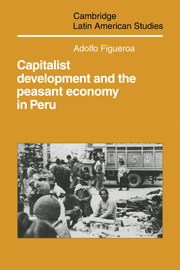Book contents
- Frontmatter
- Contents
- List of tables and figures
- Acknowledgments
- 1 Introduction
- 2 Scope and method
- 3 The economic unit and economic organization
- 4 Production and exchange
- 5 The level and structure of peasant income
- 6 The economic behavior of the peasant family
- 7 Stagnation in the peasant economy and the role of demand
- 8 Economic crisis and the peasant economy, 1975–1980
- 9 Conclusions: reality, theory and policy
- Appendixes
- Notes
- Bibliograph
- Index
- CAMBRIDGE LATIN AMERICAN STUDIES
6 - The economic behavior of the peasant family
Published online by Cambridge University Press: 04 August 2010
- Frontmatter
- Contents
- List of tables and figures
- Acknowledgments
- 1 Introduction
- 2 Scope and method
- 3 The economic unit and economic organization
- 4 Production and exchange
- 5 The level and structure of peasant income
- 6 The economic behavior of the peasant family
- 7 Stagnation in the peasant economy and the role of demand
- 8 Economic crisis and the peasant economy, 1975–1980
- 9 Conclusions: reality, theory and policy
- Appendixes
- Notes
- Bibliograph
- Index
- CAMBRIDGE LATIN AMERICAN STUDIES
Summary
Even though peasant families are organized in communities, the economic decisions that they make concerning the use of their resources and labor are fundamentally family decisions. The results presented up to now show that the peasant family is at the same time a production and a consumption unit. It is of interest to know the essential elements that determine the economic behavior of the peasant family. What are the principles guiding its economic actions? What is its economic rationality? From the answers to these questions, we can derive propositions about the mechanisms that govern the allocation of peasant family labor to alternative uses and the reactions to market prices. These are the themes that we shall attempt to develop in this chapter.
Portfolio of activities and risk-aversion
Any economic theory which attempts to explain the behavior of the peasant family of the sierra must include as an essential element the problem of risk. There are two reasons for this. First, practically all the economic activities of the sierra peasants are subject to risk and uncertainty. Agriculture in the sierra is certainly a tremendously risky activity. Since there is normally no irrigation, dependence on rainfall is complete. The absence of rain, its appearance at the wrong time, or its over-abundance (creating floods and avalanches) affect production significantly. At certain altitudes, frost and hail are climatic factors which also affect production negatively and in an unpredictable manner. To these problems of nature we must add others, such as diseases. Livestock production also confronts significant risks, such as falls (due to the rugged nature of the terrain) and strayings.
- Type
- Chapter
- Information
- Capitalist Development and the Peasant Economy in Peru , pp. 58 - 81Publisher: Cambridge University PressPrint publication year: 1984



